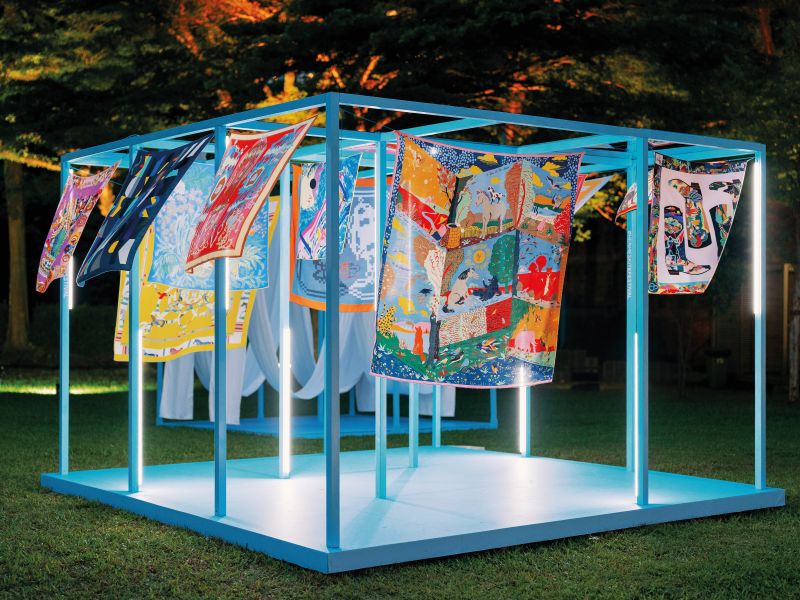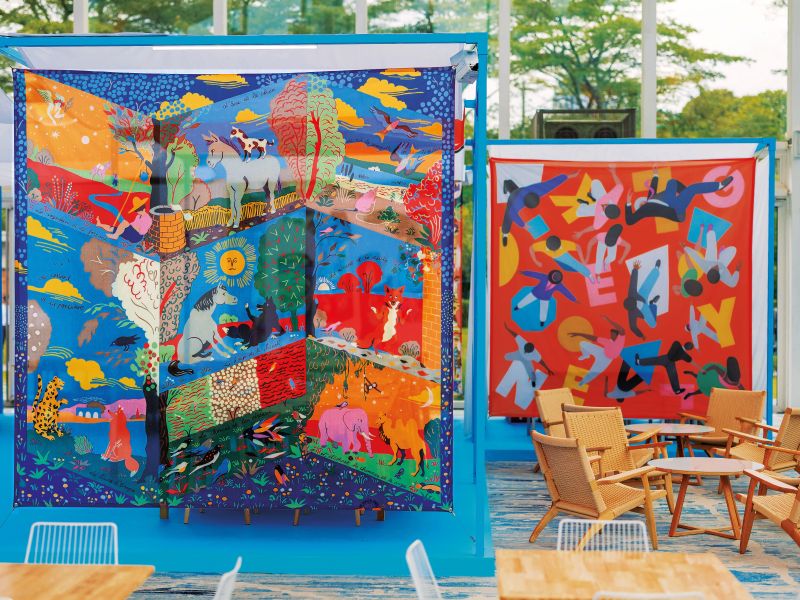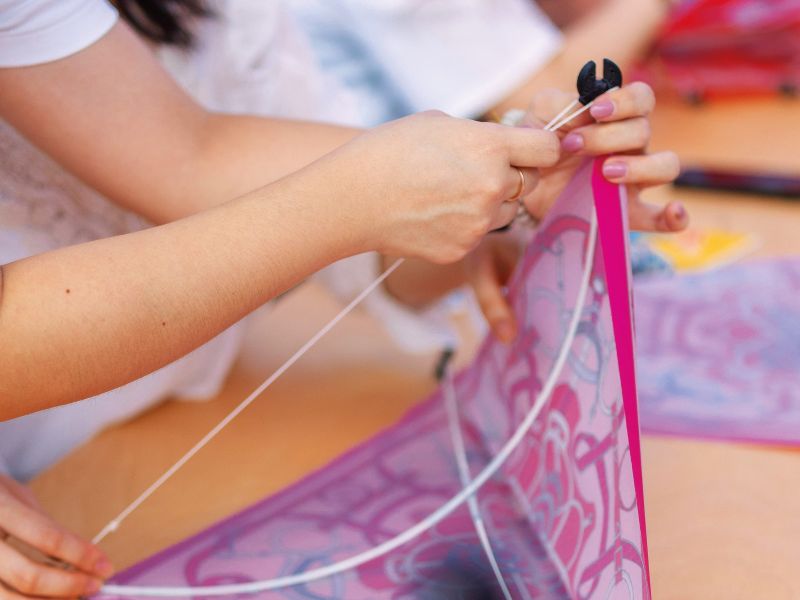
Alena Murang performed songs of sky and spirit at the KL edition of the Hermès Kite Festival (All photos: All Is Amazing/Hermès)
It begins with a square — 90cm by 90cm — of silk twill, its hand-rolled edges pulled taut like the hem of a secret. Yet, the history of the Hermès scarf, or carré as it is known to those who speak its lingo, is no mystery. Travelling through class and continents, the colourful object has been folded into the fabric of cinema, royalty, war and the cyclical carousel of fashion.
Introduced in 1937, exactly a century after the maison’s founding, the Hermès scarf was conceived by Robert Dumas. The son-in-law of Émile-Maurice Hermès, the fourth-generation family member, reimagined the utilitarian neckerchief as a medium for artistic expression. The initial design, Jeu des Omnibus et Dames Blanches, was inspired by a 19th-century board game played on the Champs-Élysées and printed on imported Chinese silk, which was twice as strong as any silk available at the time. This marked the beginning of a legacy of textiles distinguished by precision, storytelling and the exclusive pleasure of the handmade.
The Hermès scarf upholds multiple reputations, not only as a signifier of luxury, but also a canvas for ideas. In full Balmoral mode, Queen Elizabeth II knotted hers under the chin to shield against the Scottish gale. Princess Grace Kelly of Monaco famously repurposed one into an emergency sling after injuring her arm at a 1959 yacht party hosted by Greek-Argentine shipping magnate Aristotle Onassis. In Jean-Luc Godard’s Pierrot le Fou, Anna Karina wore it like a ribbon of rebellion. American rapper Tupac Shakur turned his into a bold statement of urban royalty in 1990s Los Angeles. Such semiotics are not lost on today’s discerning dresser — tucked into hairdos or tossed with an insouciant swoosh over the shoulder, the carré provides more than mere accessory or flourish; it becomes a cipher of personal narrative and the art of dressing well.
hermeskitefestivalkualalumpur-08_04192-photobyallisamazing.jpg

More than 2,000 scarf designs have been released so far, each with its own unique visual vocabulary. Some motifs appear repeatedly — the bridle, the bit, the stirrup — echoing the brand’s equestrian heritage. Others emerge like visions: a surreal jungle rendered by Kermit Oliver, the first American artist to design for the maison, who led a quiet life as a US Postal Service mail sorter for nearly 30 years alongside his artistic career; or ancient manuscripts interpreted by Pierre Marie, whose motifs read like illuminated texts. The carré, like a mirror, reflects not only the codes of the house but the world outside its boutique window.
Fast forward to modern times, a different kind of movement is stirring up. Both a sartorial symbol and creature of the breeze, the scarf morphs into something more alive, mimicking the wearer’s motion and moods. This sense of freedom found new expression at the Hermès Kite Festival held recently at Sentul Pavilion in Kuala Lumpur, where iconic silk squares were transformed into airborne artworks, celebrating the same elegance and playfulness that have defined the brand for nearly a century.
The festival first found its home by the sea — on the balmy shores of Jakarta’s Pantai Indah Kapuk in 2022, followed by Dubai’s Sunset Beach View a year later — where kites lifted effortlessly into the air, their tails sketching bright arcs against blue horizons. The KL edition, however, took a more grounded turn in a leafy enclave, as scarves, bandanas, shawls and losanges bobbed and weaved with a gentle grace, catching glints of afternoon light as they floated like butterflies. Among them, Plumets et Panaches billowed with intricate feather and plume prints; Robe Légère exuded a flowing elegance inspired by delicate dresses; and Sur Mon Nuage drifted dreamily, embellished with cloud-esque swirls.
hermeskitefestivalkualalumpur-0o4a0044-photobyallisamazing.jpg

Under the open sky, white cloths draped over metal frames formed suspended swings and hammock-like cradles, inviting visitors to lounge in comfort as professional flyers performed aerial choreographies above. Nearby, canopies provided shaded retreats where guests savoured artisanal ice cream, canapés, burgers, fries and iced refreshments made from melted lollies. Throughout the grounds, children and adults alike joined in lighthearted games, leaping across an Hermès-patterned hopscotch or darting joyfully among oversized kites pitched like vibrant tents, their shapes and shades bursting against the lush greenery.
While the outdoors buzzed with high flyers competing for airspace, creative hands stayed busy inside the pavilion, which offered an interactive workshop to assemble this age-old pastime from scratch. The crowd became a community of makers, each focused on crafting their own colourful squares — constructed from technical fabric — and sending them aloft, guided by skilled instructors and imagination. Participants could also make a special keepsake: a wooden charm shaped like a traditional wau, adorned with original Hermès silk. Small enough to hang on a bag or around one’s neck as a pendant, it was a cherished souvenir from a day spent in the wind and sun.
hermeskitefestivalkualalumpur-yh1_0266-photobyallisamazing.jpg

Amid the playful flutter of fabric in flight, the lilting strains of Alena Murang’s sape wove through the space, her voice carrying songs of sky and spirit in the endangered languages of Kelabit and Kenyah.
“The set I created comes from my 2021 album Sky Songs,” said the Sarawakian singer-songwriter, whom we caught between breaks. “We Watched the Clouds depicts the migration process in the 1900s, when my ancestors searched for new land to stay or places to fish by reading the clouds. Another song, Gitu’an, meaning ‘stars’, symbolises the belief that our ancestors were once powerful beings who could live in both the heavens and on earth, or pass through great waterfalls. We don’t believe that anymore, but when I stumbled across this story, the imagery of flying to the stars felt so magical.”
Asked about the connection between her music and how it resonated with the festival’s energy, Alena shared: “When I was pursuing my visual arts course, I actually studied Hermès scarves, which embody principles of balance, symmetry and repetition. The attention to detail and craftsmanship really spoke to me. I’m truly glad to have been invited to perform at this event.”
For a weekend, the Hermès scarf, no longer confined to the body, found a new rhythm overhead with every loop, dip and climb. The festival expanded the meaning of fashion by stepping outdoors, away from the runway and into the wind. In a time when so many are forced to stay rooted and still, a kite — in the hands of an intrepid flyer — gives us a way up and, maybe, out.
This article first appeared on May 26, 2025 in The Edge Malaysia.


